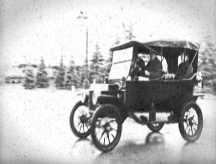Gas engines: Here to stay
Despite its limitations, the internal combustion engine won't be pushed aside so easily, but it can be made better.
NEW YORK (CNNMoney.com) -- Despite all the hype for electric cars and hydrogen fuel cells, experts say we'd better get used to pumping gas, but we can look forward to much better fuel economy down the road.
"For the foreseeable future, the gasoline engine will stay the predominant power source," said Uwe Grebe, General Motors' executive director for advanced powertrain engineering.
That's because, despite its imperfections, the internal combustion engine has a lot of inherent advantages but plenty of room for improvement. As those improvements are made, future gasoline engines will be more and more fuel efficient, making it tougher for competing technologies to show a big benefit.
Another reason is the fuel itself. Whether we're talking about diesel fuel or gasoline, it's hard to beat hydrocarbons for delivering energy in a potent, easy-to-handle package.
Small non-hybrid gasoline engine cars already get more than 35 miles per gallon on the highway. But only about 15 percent of the energy in gasoline actually makes its way to the wheels, said Fedewa.
That leaves plenty of upside potential, he said.
Gas/electric hybrid technology is a major step in boosting efficiency, but it's complex and expensive. Smaller changes are also squeezing out more of internal combustion's wasted power at lower cost.
Engineers are working on some of the subtler aspects of the engine's inner workings: The timing and spacing of the opening of valves, when and how fuel is injected into the cylinders and when the spark goes off are just some of the things that can be tweaked to extract more motive power from gasoline.
Combining all of these technologies, several car companies are working on something called "homogenous charged compression ignition" - HCCI for short - that allows gasoline engines to mimic the behavior of diesel engines.
In an HCCI engine, gasoline is ignited inside the cylinder using compression and the engine's own heat without the need of a spark. (Spark plugs are still used when the engine is cold.) While there are differences in how the engines work, this is essentially the same way that a diesel engine ignites diesel fuel.
Diesel-powered cars go up to 35% farther on a gallon of fuel than similar gasoline-powered cars. The downside of diesels is that they create more pollution, and the exhaust-cleaning technology needed to deal with that pollution is expensive.
That's why HCCI engines seem like an attractive option, provided engineers can get all the bugs worked out. HCCI engines still won't go as far on a gallon as diesel engines, in part because diesel fuel puts out more energy, but they should get about 15 percent better fuel economy than current gasoline engines, said Grebe.
Another process that's already well underway is the "electrification" of more systems within the car. In most cars now on the road, power steering and brakes get a boost from hydraulic pumps or vacuums powered directly by the car's engine. Air-conditioning compressors are also powered directly by the engine.
Many new cars now use electrically-assisted power steering and power brakes as well as electrically operated air conditioning compressors. These sorts of systems are an absolute necessity in gas/electric hybrid cars. Without them, the power steering and brakes as well as the air conditioning would stop working whenever the engine stopped.
Electrification of these accessories could add up to 10% to a vehicle's fuel economy said Nick Cappa, an advanced technology spokesman for Chrysler.
The final big step in the electrification of the car will be to remove the gasoline engine from the job of moving the car's wheels. That's the benefit of a so-called range-extended electric vehicle like GM (GM, Fortune 500)'s planed Chevrolet Volt.
While the Volt will get enough power to drive 40 miles or so just by plugging into a socket for a few hours, for longer trips extra power would come from a small gasoline engine. The engine would produce electricity that would be stored in a battery to drive the car.
Freeing the engine from directly driving the car has another big benefit. With the engine no longer connected to the wheels, it becomes easier to install entirely different powerplants in what is otherwise the same vehicle.
That could make vehicles like these the next step to hydrogen fuel cell cars. Both Ford (F, Fortune 500) and GM have created range-extended plug-in vehicles with hydrogen fuel cells to generate additional power instead of internal combustion engines.
Hydrogen fuel cells combine hydrogen with oxygen to create water while giving off energy.
The hydrogen fuel cell itself is nearing commercial viability, said GM's Grebe. The problem now is that there isn't much "hydrogen infrastructure" yet. In other words, if you were given a hydrogen fuel cell car today, finding a place to fuel it would be tough.
But talk of pumping hydrogen gas into electric cars brings to mind one of gasoline's big advantages.
The reason range-extended electric vehicles need their ranges extended in the first place has to do with "energy density." That's the amount of energy stored in a given amount of space within the vehicle, including both the fuel and whatever it's kept in.
The low energy density of batteries is what limits the range of electric vehicles. A battery big enough to take a long trip could be as big as the car itself. Compressed hydrogen, including the thick-walled tank needed to store it, is better than a battery.
But it's still not nearly as good as a simple plastic bladder filled with gasoline. If you want to go somewhere far away, there's still nothing better than gas.


